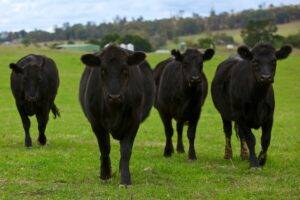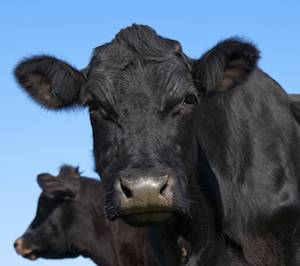Safety
As with the entire red meat sector, beef produced in the United States is subject to one of the most rigorous inspection and food safety systems in the world. Food safety management systems in the United States are science-based and are implemented to minimize food safety risks.
The latest development in this area is the recent passage of a new meat inspection law by the U.S. Congress. This Act mandates the use of Hazard Analysis and Critical Control Points (HACCP) principles in managing food safety. The seven principles of HACCP are widely recognized by scientific authorities and international health organizations as the most effective means for achieving the highest food safety standards.
These HACCP-based systems are used extensively in the United States to produce safe and wholesome meat products for the world market.
The national food safety system involves several agencies of the Federal government, packing companies and producers; all working in concert to ensure that U.S. beef is safe and wholesome.
The Food Safety and Inspection Service (FSIS) is responsible for meat and animal inspection at the packing plant; the Animal and Plant Health Inspection Service monitors and regulates animal health control; and the Food and Drug Administration approves and regulates the use of animal health products. At the packing plant level, each animal is inspected twice. The first inspection is of the live animal and the second inspection is of the carcass and internal organs to ensure U.S. wholesome products.
How do I know the beef I buy at the store is safe?
Thanks to research and cooperative industry efforts, U.S. beef is extraordinarily safe by any country’s standards. Measures to reduce and eliminate E. coli O157:H7 are in place on farms, in feedlots and in packing plants across the country. And consumers can take the final safety step at home by cooking ground beef to an internal temperature of 160 F. In addition, the Centers for Disease Control and Prevention report that the rate of illness due to E. coli O157 has declined.
What is E. coli?
E. coli O157:H7 is one of hundreds of strains of E. coli. Although most strains of this bacterium are harmless and live in the intestines of healthy humans and animals, this particular strain can cause serious illness in people. Eating food that has not been cooked sufficiently to kill bacteria such as E. coli O157:H7, or has been cross-contaminated by other foods carrying bacteria, can cause severe illness in humans.
Should I avoid beef because of E. coli?
No. Numerous safety steps take place behind the scenes in the beef production chain . The best way to deal with foodborne illnesses like E. coli O157:H7 is to continue to eat ground beef and other foods you love while implementing food safety practices a part of your cooking routine at home. This includes handling raw foods properly and always cooking meat to a specific internal temperature. For ground beef that temperature is 160 F.
What is the beef industry doing to prevent E. coli?
Food producers, from cattle ranches right to your grocery store or restaurant, use safety practices like technology, testing, scientifically-validated interventions and employee training to prevent E. coli contamination in beef. They also invest in research to find additional ways to enhance the safety of the beef supply. These overlapping safeguards are the foundation for all aspects of beef production.
Is there anything I can do at home to prevent E. coli?
Consumers play an important role in ensuring food safety at home. Make food safety a part of your routine in the kitchen. Through steps like proper handwashing, avoiding cross-contamination and using an instant-read thermometer to ensure that food has been cooked to the proper temperature, you can help eliminate the threat of foodborne illness.
What is “mad cow disease”?
Bovine spongiform encephalopathy (BSE), commonly called “mad cow disease,” is a neurological disease that can affect cattle. It does not spread from animal to animal or from animals to humans through normal contact. Most cases of the disease have occurred in Europe and steps to protect both cattle and humans from the disease have been effective in protecting the U.S. food supply from the disease.
Is U.S. beef safe from “mad cow disease”?
Yes. The beef industry has worked with the government and top scientists for more than two decades to build, maintain and expand the safeguards that protect cattle health and human food safety from BSE, commonly known as “mad cow disease.” Actions such as removal of materials that would most likely carry BSE and banning from the food supply all animals that show signs of potential central nervous system disorders help ensure beef safety from BSE in the United States.
Is organic or natural beef safer from “mad cow disease? ” Are animals raised in organic or natural programs immune to “mad cow disease?”
The strong BSE measures in place in the United States apply to all beef produced. Preventive steps – such as the 1997 ban prohibiting the ingredients that could spread BSE from being incorporated into cattle feed – serve as a safeguard for every type of beef, regardless of whether it is organically, naturally or conventionally raised. Visit the beef production section for more information on organic, natural and conventional beef.
What is Foot and Mouth Disease?
Foot and Mouth Disease (FMD), sometimes called hoof-and-mouth disease, is a viral disease that can spread among cattle and other cloven-hoofed animals. While this disease can have devastating effects on the health of animals and the livelihoods of farmers and ranchers, humans do not contract the disease. FMD is sometimes confused with Bovine Spongiform Encephalopathy (BSE), commonly called “mad cow disease,” but these diseases are completely unrelated.
Does Foot and Mouth disease affect humans?
No. Foot and Mouth Disease only affects cloven-hoofed animals, including cattle, pigs and deer. It is not a threat to public health and does not affect food safety.
As with the entire red meat sector, pork produced in the United States is subject to one of the most rigorous inspection and food safety systems in the world. Food safety management systems in the United States are science-based and are implemented to minimize food safety risks. The latest development in this area is the introduction of Hazard Analysis and Critical Control Point (HACCP) principles in managing food safety.
The seven principles of HACCP are widely recognized by scientific authorities and international health organizations as the most effective means for achieving the highest food safety standards. These HACCP-based systems are used extensively in the United States to produce safe and wholesome meat products for the world market.
The national food safety system involves numerous agencies of the Federal government, packing companies and producers; all working together to ensure that U.S. pork is safe, and wholesome. The Food Safety and Inspection Service (FSIS) is responsible for meat and animal inspection at the packing plant; the Animal and Plant Health Inspection Service monitors and regulates animal health control; the Food and Drug Administration approves and regulates the use of animal health products; and the Environmental Protection Agency monitors the air, water and soil surrounding the farms and plants. At the packing plant level, each animal is inspected twice. The first inspection is of the live animal and the second inspection is of the carcass and internal organs to ensure wholesome products. In addition, numerous microbiological tests are conducted to assure the safety of the product.



